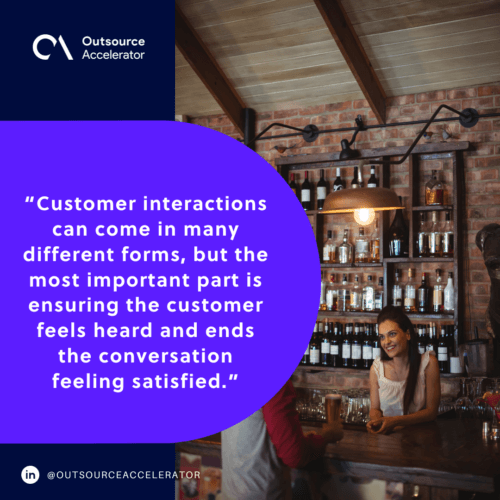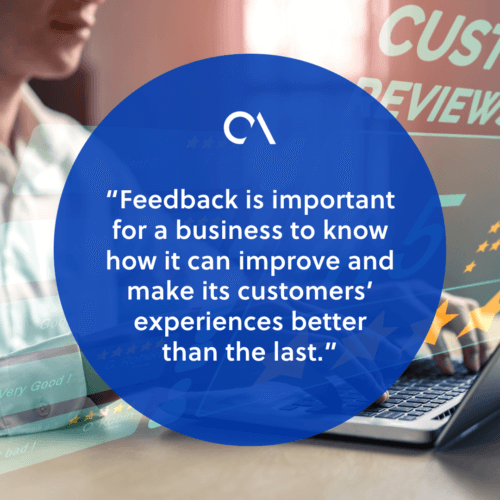What you need to know about customer interactions

Whether you are a new company or one that has been around for years, the way you talk to customers is super crucial.
Consumers bring profit to your company, so as a business leader, you must prioritize ensuring they are treated well with every interaction.
This article breaks down the importance of customer interactions and how each one can guide your business toward success.
What are customer interactions?
Customer interactions are every time the business and customer communicate. These can come in many different forms, but the most important part is ensuring the customer feels heard and ends the conversation feeling satisfied.
Interactions can happen across different business channels, such as face-to-face, emails, social media, phone service, and chatbots.

Importance of customer interactions
If customers’ conversations with company representatives do not go well for whatever reason, there is a high chance that they will not return to that company.
No matter how big or small, customer interactions are very important for building buyer-seller relationships. They play a huge part in keeping a business going and ensuring customers have a reason to return.
Customers come in with specific expectations in mind whenever they interact with business. It is your job as the company to meet those expectations to establish yourself as a trusted brand.
Customer interactions examples
Customer interactions can happen in many ways and in different facets of a business. Here are some common examples consumers will likely encounter:
Marketing
Interacting with customers is a great way for companies to market their brand. It is a type of connection made between the brand and one person that is meant to establish a connection and build trust.
Whether it is a personal interaction or one intended for a large group of people, these types of interactions help boost engagement and entice potential customers to look into the brand.
For example, when a customer sees an ad on social media and comments on it, the brand may reply with its personalized comment.
Another example of customer interaction through marketing is signing up for newsletters or attending company events.
Sales
Of course, when a company launches a new product, it must first be tested to ensure that it functions correctly.
This is the brand’s chance to talk to the customers, tell them about the product, and convince them to buy it themselves. This can be in the form of product demonstrations or offering discounts for the first set of buyers.
If this interaction goes well, the brand has successfully converted potential customers into buyers.
This is also the company’s chance to reach out to customers who have churned or are showing signs of churn. By approaching the situation carefully and respectfully, a company may successfully convince these customers to use their products again.
Customer service
Customer service is one of the most common forms of interaction. Customers use many different communication channels to seek assistance from company representatives.
This can be in the form of phone calls, live chat, or chatbots. A brand may use this time to listen attentively to the customer’s issues and guide them toward resolving them.
Customers can even leave questions or concerns on the company’s social media accounts, which the company can respond to. This way, if other customers have the same question, they can refer to the answer left by the brand.
This type of interaction builds trust between the two sides, showing that the brand is willing to go out of its way to help and support the customer through their concerns.
Feedback
Another way customers and businesses interact is when the latter asks the former for feedback.
Feedback is important for a business to know how it can improve and make its customers’ experiences better than the last.
Some ways to ask for feedback are through surveys or leaving a product review for the company to respond to. Customers can also relay feedback over the phone or via email.

Stages of customer interactions
When monitoring customer interactions, it is helpful to take note of the different stages of the interaction:
Stage 1: Greeting the customer
All customer interactions start off with a greeting, and of course, you want a pleasant greeting to make a good first impression.
Greetings set the tone for your interaction with the customer, so greet them shortly but kindly.
Some quick greetings can include thanking the customer for reaching out and asking how you can be of assistance.
Stage 2: Understanding customer needs
The understanding stage is a big part of the interaction. This is the company’s chance to listen attentively to the customers.
They may have a question or concern regarding a product or service, and it is up to the company to pay attention to resolve it immediately.
You may need to ask multiple questions in order to get to the cause of the problem. Actively listen to what they are saying so that you may provide the most appropriate solution.
Remember to let customers finish saying everything they have to without interruptions. Repeat and take note if needed and confirm details once you have heard them.
Stage 3: Agreeing to help
Once you have heard the customer’s concerns, assure them you will help them through it.
Walk the customer through some possible solutions so they may understand how exactly you will help. Be honest about what you are capable of doing and not doing.
If the customer’s issue requires more time to solve, it is best to go the extra mile and seek additional professional help.
Otherwise, if there are no possible solutions, try to compensate by offering perks like exclusive discounts, alternative products, or special items.
Stage 4: Delivering
Once the two sides have agreed on a solution, the next step is execution. Keep the customer updated on your progress and possible setbacks you may encounter.
Additionally, maintain communication with them and inform them of the next steps.
Stage 5: Closing
After delivering on your promise, close out the interaction by asking if the customer needs any additional help. The goal is to end the conversation with a happy and satisfied customer.
However, the interaction does not stop there. Follow-up calls, emails, and surveys are a great way to know if your customer is happy with your service.
Benefits of good customer interactions
Effective customer interactions can go a long way. Here are some ways customer interactions can make a difference in your business:
Better customer experience
Meaningful interactions make things better for the customer as they give them a reason to trust the brand’s products and services.
Furthermore, it gives customers an avenue to voice their concerns and opinions since they know someone will accommodate them.
Enhances brand image
Brands that treat their customers well and with respect enhance their overall reputation. It shows that they are approachable and competent in handling concerns.
This already puts you ahead of your competitors as customers will put in a good word for you and will choose your brand over others.
Increases profit margin
More happy customers mean more profit for the company. Sometimes, all it takes is a good one-on-one with a customer for them to be converted into paying customers.
Other times, a healthy interaction could mean the difference between someone choosing your brand over a competitor’s.
Tips to maintain effective customer interactions
Interacting with customers may be nerve-wracking, especially for new businesses. Here are some tips to help you perfect each interaction:
Personalize your interactions
Each customer is different, meaning each interaction must also be different. Personalize every conversation you have so as to not come off as robotic or merely reading off a script.
Doing so will allow you to build personal relationships with the customer and empathize with them.
Create a multichannel interaction plan
Customers prefer interacting with brands when it is most convenient for them.
You can do this by offering them many different options to interact with. This includes social media, forums, or review sites.
Each channel may be different from one another, but it is still important to maintain the same professionalism.
Train your team
New team members may be nervous about facing customers for the first time, so it is best to train them and show them the ropes.
It would help to facilitate role-playing sessions and recreate potential situations when interacting with customers to prepare them for the real thing.
All customer interactions matter
Regardless of who your customers are or how long your conversation with them is, every customer interaction is important and plays a role in the success of your company.
As mentioned earlier, these interactions can make or break the company. Treat your customers how you want to be treated and handle each interaction delicately.
Leading BPOs like SixEleven understand the importance of delivering personalized and efficient support that leaves a lasting impression. Visit SixEleven’s Live Chat Support Services and discover how its professional team can help your business thrive.







 Independent
Independent




